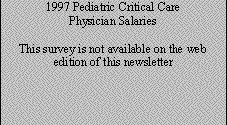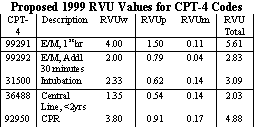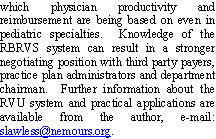CRITICAL CARE NEWS
The Newsletter of the Section on Critical Care of the American Academy of Pediatrics
Volume 5![]() Number 3
Number 3![]() October, 1998
October, 1998
This issue is available as an Adobe Acrobat pdf file here
(get free reader software)

|
|
|
|
![]()
Critical Care News![]() is the newsletter of the
is the newsletter of the
Section on Critical Care of the American
Academy of Pediatrics. We hope to keep you
abreast of activities and opportunities in Pediatric
Critical Care. We plan to run current news,
advertisements for positions, and other articles of
interest to you. Please let us know how we are
doing.
![]()
![]() Submissions to Critical Care News
Submissions to Critical Care News
![]()
Members of the Critical Care Section may submit
announcements and articles to Critical Care
News. Priority will go to articles of current
interest to pediatric critical care practitioners. We
hope to run announcements for available critical
care staff positions in future issues.
|
|
With the trend towards declining physician
residency and fellowship training programs
nationwide, how intensive care units will
provide physician staffing in the next
decade is often discussed. The time may be
right to begin to look to another profession
to enter and make an impact upon this work
force.
![]()
For over thirty years physician assistants in
the United States have practiced medicine
with physician supervision. From the first
four graduates in 1967, the profession has
grown to over 32,000 in 1997. There are
now 106 accredited PA programs that
graduate more than 3500 students annually.
Between 1991and 1996, the number of new
PA graduates produced each year increased
83 percent, the cumulative number of PAs
increased 38 percent, and the estimated
number of PAs in clinical practice increased
41 percent. Physician Assistants practice in
all practice settings, in communities of all
sizes and provide a wide range of medical
services.
![]()
In the 1997 census survey conducted by the
American Academy of Physician Assistants,
37.8 percent of respondents report that they
spend more of their work time in the
hospital than outpatient setting. In another
question, 28 percent of the respondents
report that they are employed by a hospital.
2.4 percent report that they work full time in
an intensive care unit.
![]() Continued on page 2
Continued on page 2





